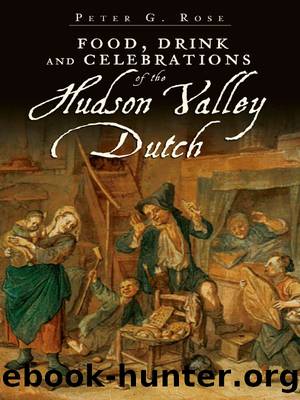Food, Drink and Celebrations of the Hudson Valley Dutch by Peter G. Rose

Author:Peter G. Rose [Rose, Peter G.]
Language: eng
Format: epub
ISBN: 9781596295957
Barnesnoble:
Publisher: History Press, The
Published: 2009-03-16T00:00:00+00:00
Chapter 6
THE SAINT NICHOLAS CELEBRATION
The legend of Saint Nicholas is like an elaborate piece of embroidery with many intertwined threads, threads that start in the fourth century and wind their way through history to the present day, not only in Asia Minor and Europe, but also in North and South America.
He is believed to have been the bishop of Myra, present-day Kale, on the south coast of Asia Minor between the islands of Rhodes and Cyprus. He is said to have died on December 6, AD 343, or in any case between AD 340 and AD 350. December 6, as âNicholas Day,â is part of the Roman calendar. Saintsâ days are generally celebrated on the day of their death (and their rebirth in heaven). In Byzantine icons, Nicholas is portrayed as a bishop dressed in the vestments of the Eastern Orthodox Church, wearing an omophorion, the symbol of his spiritual and ecclesiastical authority. Originally of wool, it is a band of brocade decorated with crosses and is worn about the neck and shoulders. In modern portrayals, he is clad in the vestments of a bishop in the Roman Catholic Church.
Nicholas was the son of well-to-do parents, and according to the tales about him, he was already pious as an infant. On the fasting days of Wednesday and Friday, he would only suckle at his motherâs breast once a day, just enough to sustain him. He grew up into a pious man associated with many miracles. I must point out, though, that the first encomium of Saint Nicholas (the description of the life of a saint) was written between 814 and 840, nearly five hundred years after his death, which explains the confusion in the details of his life and the hesitation of historians in pinpointing incidents. For example, Jeremy Seals mentions that although Saint Nicholasâs life and that of Nicholas of Sion (the abbot of a monastery situated above Myra) are often confused, there is a reference dating to the sixth century that seems to confirm that they were two separate people, as Nicholas of Sion is said to have gone to the grave of Saint Nicholas in Myra.
Download
This site does not store any files on its server. We only index and link to content provided by other sites. Please contact the content providers to delete copyright contents if any and email us, we'll remove relevant links or contents immediately.
Biscuits: A Savor the South Cookbook by Belinda Ellis(4216)
A Jewish Baker's Pastry Secrets: Recipes from a New York Baking Legend for Strudel, Stollen, Danishes, Puff Pastry, and More by George Greenstein(3452)
Al Roker's Hassle-Free Holiday Cookbook by Al Roker(3428)
Ottolenghi Simple by Yotam Ottolenghi(3428)
The French Women Don't Get Fat Cookbook by Mireille Guiliano(3415)
Better Homes and Gardens New Cookbook by Better Homes & Gardens(3372)
Trullo by Tim Siadatan(3304)
Bake with Anna Olson by Anna Olson(3280)
Hot Thai Kitchen by Pailin Chongchitnant(3215)
Panini by Carlo Middione(3166)
Nigella Bites (Nigella Collection) by Nigella Lawson(3096)
Momofuku by David Chang(3053)
Modern French Pastry: Innovative Techniques, Tools and Design by Cheryl Wakerhauser(3029)
Salt, Fat, Acid, Heat: Mastering the Elements of Good Cooking by Nosrat Samin(3000)
Best of Jane Grigson by Jane Grigson(2871)
Tapas Revolution by Omar Allibhoy(2855)
Classic by Mary Berry(2837)
Solo Food by Janneke Vreugdenhil(2825)
The Club by A.L. Brooks(2748)
